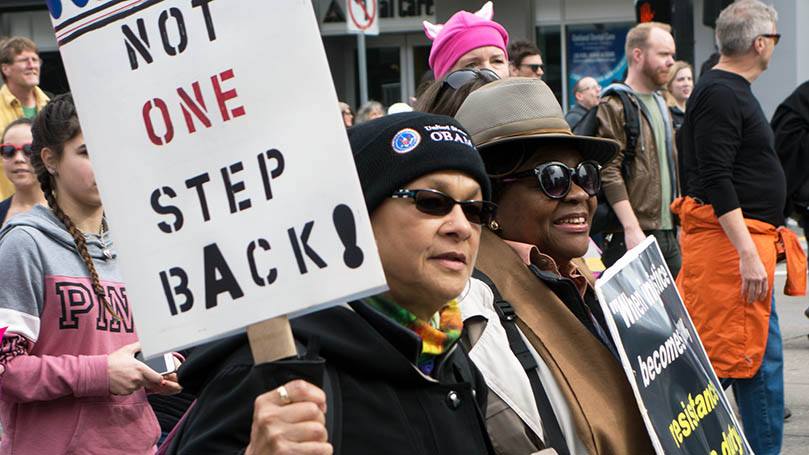
This article is based on a report to, and subsequent discussion among, the National Board of the Communist Party USA.
I. What is the Resistance?
The thing we call the resistance is heterogeneous, made up of different forces, each with their own objectives and tactics in struggle. It brings together some, including moderate Republicans, with the narrow goal of returning to the status quo ante by removing the Trump regime. Other forces see removing Trump as part of a larger Democratic electoral campaign against the GOP.
At its broadest, though, the resistance includes those demands and also fights for a mass democratization of society—the empowerment of new voices and new forces, raising old questions in a new way and mobilizing to demand effective answers. This resistance includes movements on behalf of the poor and low-wage workers, immigrants, and people of color. It also includes the historic, international campaign of women and their allies against male supremacy, sexual assault, and sexual harassment (#MeToo in English; in French, #BalanceTonPorc, “toss out your pig”). It has come to include, most recently, the student- and women-led drive for gun control.
This broad movement for democracy and equality is changing what is up for debate. Its goal is to recenter politics around what the people need, rather than what is considered possible or expedient. In all of these struggles, women are at the forefront–not just doing the ‘heavy lifting’, but giving political leadership.
In addition to women’s leadership across the spectrum of democratic struggle, the movement that coalesced around the Women’s Marches represents a gathering of formidable political energy with the potential to bring significant numbers of people into political struggle, on multiple fronts.
II. Characteristics of the Women’s March movement
Breadth of demands
It is tempting to refer to this movement as ‘the women’s movement’, but we have to use that term cautiously. While the current movement continues to press the unmet demands of the historic women’s movement—political empowerment, equal pay, social and sexual equality, and reproductive rights—it goes beyond them as well.
Because it was born in response to the election of Donald Trump and the empowerment of the most reactionary and anti-science wing of the Republican Party, slogans taken up by marchers include demands for transparency and honesty in politics, for science-based health and environmental policy, and for the defense of public education.
Moreover, the movement allows the coexistence of demands all along the political spectrum. At the march in Seneca Falls, for example, speakers ran the gamut from the Lt. Governor of New York, a moderate Democrat, to the Bear Clan Mother of the Mohawk Nation, who delivered a radical denunciation of settler colonialism and the role of women in anti-capitalist resistance. A similar spectrum of slogans, demands, and political affiliations was visible among marchers.
What wasn’t present was the spirit of competition between more radical and less radical elements. Rather, there was a sense of a common enemy and a common ground of struggle where groups might take different, though not antagonistic, positions. The women’s march movement has attracted criticism from some forces on the left for not being inclusive enough of poor women, women of color, and trans women, but our response should basically be the one given by Keeanga-Yamahtta Taylor: “Think the Women’s March wasn’t radical enough? Do something about it.”
Class basis of the movement
The class basis of the Women’s March movement deserves serious consideration. It consists largely of college-educated ‘professional’ women, including educators at every level. It also includes women small business owners. Ninety years ago, it would have been considered a movement of the ‘democratic petty bourgeoisie’.
Times have changed, however, and the majority of professional and intellectual work has been reshaped as wage labor, subject to the same pressures and insecurities. Educators are the prime example of this process: once petty bourgeois, now a major and militant part of the working-class movement (as we just saw in statewide wildcat strike of West Virginia teachers!). If we define the working class as composed of wage-workers, the composition of the Women’s March movement is largely working class. It is important to note, though, that some sectors of the working class—industrial workers and low-wage workers—are less represented than others. The absence of low-wage workers is especially problematic, since nearly two-thirds of minimum-wage workers are women.
Some of the key demands of organized labor and other working-class forces are represented within the Women’s March movement, notably pay equality and paid family leave. Moreover, the overarching issues of democracy and equality raised in the Women’s Marches represent the core interests of the working class.
So, while the Women’s March movement is not a workers’ movement, it is a movement largely (but not exclusively) of the working class, rooted in the struggle for democracy and with the capacity to amplify the struggle for key working class demands.
Changing electoral politics
The republic is a strange kind of democracy. We don’t make decisions for ourselves; instead, we elect people to make them for us. That leads to a couple of different strategies to translate our goals into political realities.
One is to pick a candidate and back them, hoping that our support will be repaid when the candidate is in a position to advance our interests legislatively. Another strategy is to concentrate on building a movement around issues to the point where elected officials are forced to respond. Both of these are standard practice in the broad democratic movement.
What has emerged since Trump’s election is vastly increased emphasis on producing candidates, rather than backing or influencing candidates. The Women’s March movement is definitely part of this trend. Rather than just rallying around women candidates or putting pressure on candidates to address women’s issues, the focus is very much on getting activist women to run for office. As such, this movement will amplify efforts already underway by labor and community organizations to get grassroots progressives on the ballot.
‘Revolutionary’ scope
Most of the people drawn into struggle around the Women’s March and the question of women’s equality are not veterans of revolutionary politics. They do use the word ‘revolution’, though, and they show a profound optimism about the possibility for social change on a very large scale. They’re pretty sure that a world where women are treated equally will be very different than our current one—and they celebrate that possibility.
That optimism and openness to large-scale change are vital. They represent a break with a form of politics centered on what can be done, and a turn instead toward what must be done to meet the people’s needs—new, and higher, expectations of what political struggle is and what it can accomplish.
III. Contribution of CPUSA
The role of the CPUSA is not just to support the Women’s March movement by engaging our members in it, but to help develop class consciousness and working-class political leadership within it, connect it theoretically and organizationally to other struggles.
The basis of our contribution is the understanding that there is not a competition between class struggle and democratic struggle. Nothing that promotes equality hinders or distracts from class struggle; nothing that advances the interests of the working class hinders or distracts from the fight for equality. On the contrary, struggles like the women’s movement are essential to building the unity and power of the working class.
Broadening the Women’s March movement
One of the ways CPUSA can contribute to this movement is by engaging our members in it—especially our male members. Many of the men who come to us don’t yet understand the importance of the fight against male supremacy and misogyny. Part of our job is to get them active in that struggle—from holding signs in a Women’s March to making sure that work in our collectives is done in ways that reflect our commitment to equality.
Part of this work, too, involves building on what we are already doing. Our party is the home for people looking for equality and change. As we mobilize our people and our social media in the struggle against male supremacy, we should amplify the voices of women of color, trans women, poor women, immigrant women, women with disabilities, and others who may face barriers—formal or informal—to participating in the political work of the resistance.
Theoretical and educational work
Another area in which CPUSA can make a significant contribution to the Women’s March movement and the broader women-led resistance is by devoting theoretical and educational work to the question of how male supremacy functions within, and for, capitalism.
One aspect of Marxism that deserves some attention in relation to the women’s movement is reproductive labor, that is, the work that goes into producing, training, and caring for wage workers to keep the working class working. Capitalism has traditionally assigned this labor to women, who are expected to perform many of these necessary tasks without pay. While many families now have two wage earners, women are still expected to take primary responsibility for unwaged reproductive labor—meaning that women face double exploitation in the current configuration of capitalism.
In terms of the need to broaden the Women’s March movement, we should also devote some of our work to the ways in which homophobia, transphobia, and male supremacy/misogyny overlap, and how the most reactionary section of capital uses them. The same goes for white supremacy and male supremacy, and how capital uses them together to cement its power over the working class.
Connection to other struggles
In the coming months, the struggle for union rights in the public sector will be at the top of the agenda for the organized working class. As we’ve seen in Wisconsin, in Chicago, in Puerto Rico, in Parkland, and in West Virginia, public-sector unions (and teachers in particular) are on the leading edge of the fight for democracy and economic justice. With an unfavorable decision in Janus v. AFSCME on the horizon, those unions are facing a huge setback in their ability to organize. The decades-long attack on public workers’ unions disproportionately impacts women, especially Black women. Connecting the energy of the women’s movement to the defense of public services and public workers should be a key priority.
Likewise, the Fight for $15, the Poor People’s Campaign, and the immigrants’ rights movement are natural allies of the women’s movement. All movements with a strong presence of women in their leadership; both struggle on issues that disproportionately impact women—issues that are also of primary importance to the working class and organized labor.
Public services, welfare, wages, immigrants’ rights, women’s rights: the 2018 elections are a major battleground on all of them. Without breaking the power of the right wing at the state and federal level, no progress is possible. The mass mobilization around the elections, which includes the Women’s March movement, is also a key arena for forging real connections between the different working-class and people’s struggles.
Conclusion
In 1905, in the midst of a broad and growing democratic insurgency against the tsar, Lenin wrote “Two Tactics of Social Democracy in the Democratic Revolution.” Under this cumbersome title, he presents a couple of his most important strategic insights: first, that the power of the working class must be built within the struggle for democracy; and second, that only the working class can carry the fight for democracy all the way to its conclusion, in socialism.
These insights continue to guide our political practice.
Capitalism turns politics into a competition of interest groups, fighting over a piece of the pie. In a capitalist perspective, women’s struggle and working-class struggle are conflicting sets of political demands. From our perspective, however, building class consciousness and working-class leadership in the women’s movement doesn’t undermine it. Instead, it brings out and amplifies its core democratic content: the demand for full equality as the basis of social life.


 Join Now
Join Now